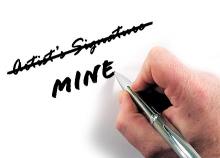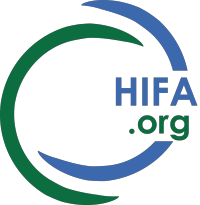
Quote of the month: “I am my own plagiarism software and have not used any of the trademark software. This is because I learnt to consciously cite as appropriate.” (HIFA member Olufemi Ajumobi, National Malaria Programme, Nigeria)
In December 2018, HIFA members discussed findings from a new study in BMJ Open to determine whether African biomedical journals had policies on plagiarism and the means to detect it. The authors also measured the level of plagiarism in research articles and reviews. Working with a sample group of 100 African biomedical journals from the African Journals Online database, they randomly selected 5 original research papers from each one. These were then submitted to ‘Turnitin’, a ‘text-matching’ software application (TMS) which detects plagiarism (copying the work of others) or text recycling (copying of one’s own work) within the papers by ‘matching’ them to a large database of online sources.
The study revealed a high incidence (63%) of plagiarism across the journals in the sample group; that is, some text copied without attribution from other sources. It was found mainly in the introduction, discussion and methods sections of research papers. Significantly, only 26 of the journals surveyed had a policy on plagiarism and 16 of these referred to the use of text-matching software (TMS). The authors suggest that the high cost of software licences may explain the low uptake of TMS within African countries. As Chris Zielinski (HIFA Steering Group member, UK) stated on the HIFA forum, however, increasing numbers of major publishers have already adopted TMS to protect themselves from what he described as, ‘the financial and legal risks of publishing research that can be shown to infringe someone else’s copyright’.
The widespread availability of TMS has helped to raise awareness of both integrity and misconduct in research. The Committee on Publication Ethics (COPE) publicly encourage journal editors to screen manuscripts for plagiarism. Initiatives such as the African Journals Partnership exist to help smaller publishers keep up with developments. “There actually should be no confusion about acknowledging sources fully to avoid plagiarism", explained Joseph Ana (HIFA Steering Group member, Nigeria), “irrespective of your fluency or literacy in English or any other language.” Najeeb al-Shorbaji (HIFA Steering Group member, Jordan) agreed, citing the importance of a thorough grounding in ethics and education. “Without them”, he added, “writers will find ways to plagiarise.” In the meantime, Najeeb acknowledged that the language coverage of TMS was still limited mainly to English-language resources. Jo Anne Bennett (HIFA member, USA) agreed. “We know for a fact “, stated Jo Anne, “that more materials in languages other than English are not available in digital format. These materials do not go through the plagiarism tests”.
Despite the emergence of TMS, why do researchers continue to plagiarise? “Many authors (especially in the developing countries)”, stated Armand Seraphin Nkwescheu (HIFA member, Cameroon), “may be tempted to access the position of senior writer when they are not 'ripe' for the position”. The author of our Quote of the Month, Olufemi Ajumobi (HIFA member, Nigeria) suggested that some plagiarism may be unintentional and explained how authors can fall into the trap. “At times, it is possible to become so familiar with some words and unknowingly use them as if they are yours” he told the forum. “This can occur if you have read those articles several times. The best way forward in this scenario is to consciously make an effort to cite appropriately”.
Even if the words are 'yours', they still have to be cited as such. Self-plagiarism or 'text-recycling' occurs when an author re-uses text from a previous publication without stating this. Self-plagiarism is important because it misleads both reader and editor into thinking that the words are original. Old data is mixed with new, and the publication record is distorted so that it appears that the author has published a higher volume of original research than is the case. As Chris Zielinski told the HIFA forum, when authors self-plagiarise to boost their reputations, "this is fraud committed for the purposes of reputational or financial gain."
Where does this leave the research scientists of the future? How do we prevent them catching the 'plagiarism plague'? Tambo Ernest (HIFA member, Cameroon) and his team at Universite de Montagnes (UdM) may have the solution. They have recently developed and launched “Operation No to Plagiarism”, a plagiarism outreach model. This is aimed at undergraduates (Tambo hopes it might evolve to reach secondary schools) and provides the kind of grounding ethics and good practice, previously mentioned by Najeeb. Tambo reminds us that young scientists are living in a century characterised by fake news and misinformation. As he told HIFA members, “Plagiarism outreach in the University environment is crucial and valuable. This is essential in nurturing new generations of Africans and world leaders and scientists to believe, build trust in and use evidence based information for all”
Metrics: In December 2018 HIFA (English) exchanged 198 messages from 80 contributors in 26 countries (Belgium, Cameroon, Canada, China, DR Congo, Egypt, Germany, Ghana, Grenada, Honduras, India, Italy, Jordan, Kenya, Nepal, Netherlands, Nigeria, Romania, Rwanda, Switzerland, Tanzania, Tunisia, Uganda, UK, USA, Zambia). Our top contributors were Chris Zielinski (14), Joseph Ana (8), and Isabelle Wachsmuth (7). Thank you all for sharing your views and your experience.
Martin Carroll was previously Head of the International Department at the British Medical Association, London UK, and has worked on issues affecting health in LMICs since 2003. He represented the BMA on the HIFA Steering Group from 2008-16 and is now an independent HIFA Steering Group member. Martin is a member of three HIFA working groups: Multilingualism, Evaluating the Impact of Healthcare Information, and Social Media. He is also the HIFA blogger. Twitter: @MMCarroll
Image credit: Ryan Minkoff, CC BY-SA 4.0 & Wikipedia

